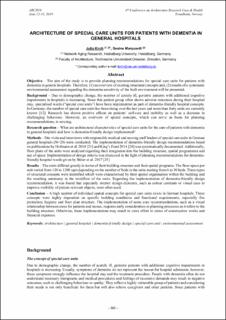| dc.description.abstract | Objective – The aim of the study is to provide planning recommendations for special care units for patients with dementia in general hospitals. Therefore, (1) an overview of existing structural concepts and, (2) results of a systematic environmental assessment regarding the dementia-sensitivity of the built environment will be presented.
Background – Due to demographic change, the number of acutely ill, geriatric patients with additional cognitive impairments in hospitals is increasing. Since this patient group often shows adverse outcomes during their hospital stay, specialised wards ("special care units") have been implemented as part of dementia-friendly hospital concepts. In Germany, the number of special care units has been rising over the last years and more than forty units are currently known [12]. Research has shown positive effects on patients’ self-care and mobility as well as a decrease in challenging behaviour. However, an overview of spatial concepts, which can serve as basis for planning recommendations, is missing.
Research question – What are architectural characteristics of special care units for the care of patients with dementia in general hospitals and how is dementia-friendly design implemented?
Methods – Site visits and interviews with responsible medical and nursing staff leaders of special care units in German general hospitals (N=20) were conducted. The implementation of dementia-friendly design recommendations based on publications by Hofmann et al. 2014 [23] and King’s Fund 2014 [24] was systematically documented. Additionally, floor plans of the units were analysed regarding their integration into the building structure, spatial programmes and use of space. Implementation of design criteria was discussed in the light of planning recommendations for dementiafriendly hospital wards given by Büter et al. 2017 [25]
Results – The units differed greatly in terms of their building structure and their spatial programs. The floor space per unit varied from 120 to 1200 sqm depending on the number of beds in the units starting from 6 to 30 beds. Three types of structural concepts were identified which were characterised by their spatial organisation within the building and the resulting autonomy in the workflow of the units. Regarding the implementation of dementia-friendly design recommendation, it was found that especially interior design elements, such as colour contrasts or visual cues to improve visibility of patient-relevant objects, were often used.
Conclusion – A high number of individual spatial concepts for special care units exists in German hospitals. These concepts were highly dependent on specific building conditions and functional requirements, especially fire protection, hygiene and floor plan structure. The implementation of some core recommendations, such as a visual relationship between areas for patients and nurses, requires early consideration in planning processes as it refers to the building structure. Otherwise, these implementations may result in extra effort in terms of construction works and financial expenses. | |

